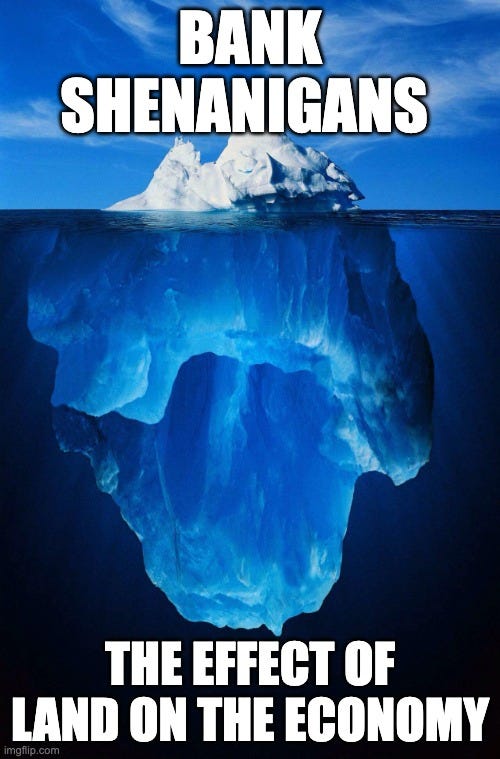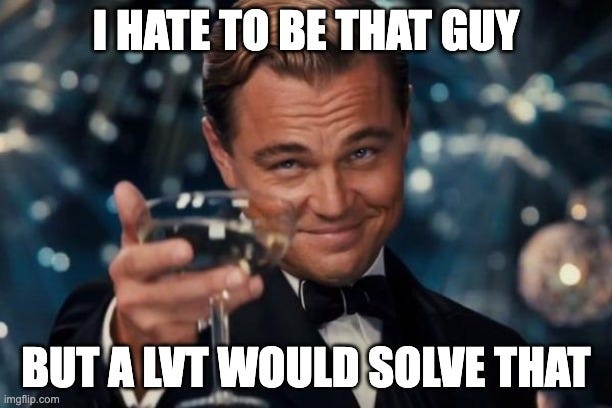Could Georgism have prevented SVB's collapse?
A Georgist interpretation of this year's banking woes.

What a stressful time for the banking sector! There are many questions: Is this another 2008? Should we regulate banks more? Was this a bailout or a backstop? Does Twitter doom us to a future of endless bank runs?
Today, I wanted to consider what a “Georgist interpretation” of the stress in the banking system might look like. (After all, why should Marxist’s get to have all the fun?)
The Beginning of the End of an Inflationary Cycle
For the past 15 years, the Fed has pursued an inflationary policy of historically low interest rates.
Why are low interest rates inflationary?
The Fed keeps interest rates low by “expanding the money supply” aka “printing money”. (And they really went whole hog on the money printing in 2021 and 2022!)
To do this, the Fed increases the supply of money that banks have on hand to lend by purchasing Treasuries from commercial banks.
As with most things, a glut of supply drives prices down. Since the interest rate is the price of money, more money in the system lowers interest rates.
For most of the past fifteen years, low interest rates have not seemed inflationary because they created asset bubbles in many sectors of the economy which made people feel much richer.
When your house doubles in value, you don’t think: wow there has been a lot of inflation in the price of housing. You think: I am being justly rewarded for my shrewd investment! Only recently has inflation crept into the rest of the economy and made people feel poorer.
Why did the Fed keep interest rates low for so long?
Low interest rates are good for business!
A low price of money might make it easier for me to open a pizza joint. If successful, I will earn enough profit to pay back the loan with interest.
And my future profits will grow the economy through my spending and tax payments. The extra money in my pocket will flow to the flower shop next door. And my taxes will fund vaccine research at tax-payer funded institutions like UCSF!
When the majority of loans in an economy go to productive businesses, the economy can keep growing.
The role of land in the economy
Georgists note that most bank loans don’t go to fund businesses like pizza joints. Rather, the majority of bank loans are used to purchase real estate.

The Fed treats growth in the real estate market like any other sector of the economy like retail, travel, hospitality, or technology. Accordingly, they keep interest rates low to support the real estate market.
But Georgists point out that real estate is different than pizza joints because real estate is only partially a productive business.
Investing in improvements is productive: When you build buildings and improve land, you are creating new wealth. If I add a 10-unit building where previously there was a single-family home, that is new wealth. And it will put downward pressure on the price of housing.
Speculating in land is not productive: Land is zero sum. It’s the fool’s gold of wealth. When the price of land goes up, no societal wealth is created. For something to be new societal wealth, it has to be well, new. And land cannot be new because it cannot be created. When land prices rise, dollars that could have gone to Labor and Capital are merely transferred to landlords.
New wealth tends to make goods cheaper and more abundant. In 1900, no one had air conditioning or penicillin and practically no one had a car. But today even the poorest Americans have access to all 3!
In contrast, higher land prices without improvements cause things to get more expensive over time. Even if new technology makes pizza making cheaper, rising land prices will drive the price of pizza up because the people serving it need to pay more rent.
Low interest rates cannot go on forever
To recap:
The Fed prints money to fuel growth in the economy, which mostly turns into real estate loans. For awhile, people feel richer as their property values rise.
At some point though, rising land prices cause other goods and services to become more expensive. People feel poorer. To stop this inflation, the Fed has to hit the brakes. They raise interest rates to slow the economy down.
The banking troubles of March 2023 were caused by this abrupt rise in interest rates. The Fed went from 15 years of very low interest rates to a 5% interest rate basically overnight.
SVB and other banks did not adequately account for the risk that interest rates would rise. So we had a banking crisis.
Will more regulation of banks help?
Given the experience of 2008, many feel a frustrating sense of deja vu. Didn’t we learn our lesson?
It’s easy to look at the fact that Silicon Valley Bank successfully lobbied to be exempted from certain regulations in 2018 and conclude that more regulation will fix this.
But are we running a fool’s errand? I see two reasons to worry that regulation won’t be enough:
First, for decades, our best and brightest have been lured by big money into the financial sector. It’s going to be very hard for regulators to keep up with them. Banks have so many more resources than regulators. Banks will “innovate” around regulations and lobby against those they can’t. Again, despite it being the 10th anniversary of a historic banking crisis SVB was able to weasel out of regulations designed to prevent these crises.
Second, any regulatory regime is likely to ignore the role that a fixed quantity of land plays in our economy (see: Will there be a housing crash in 2026?). There is a reason that we tend to have banking crises every 10-15 years. And no regulation will solve it until we fix the underlying cause.
What we really want is de-financialization
Rather than bank regulation, what I think we actually want is less financialization of our economy.
The financial industry went from 2.5% of GDP in 1947 to 7.5% of GDP in 2010. Over that period it went from making 10% of business profits to 50%.
Don’t we want our banks to be just big enough to support our economy without becoming “too big to fail”? And don’t we want our best minds building things and creating life-saving drugs instead of creating the next version of credit default swaps?
A land value tax would make banks smaller
Instead of making temporary rules about what banks can and cannot do, we could just make banking less lucrative.
A Land Value Tax can achieve this in two ways:
First, by giving a major haircut to the mortgage industry. About 75% of the price of an average property is for land, and 25% is for improvements. That means a $1M home is actually a $250,000 home sitting on $750,000 of land.
Land Value Taxes drive the land value to $0 by taxing away the annual return to land. So under an LVT, you could buy the same $1M home for $250,000. That is a 75 percent reduction in the size of the mortgage you need to buy that house.
Since a majority of US bank loans go to real estate, a 75% haircut on all mortgages would greatly reduce the financial sector’s share of the overall economy.
Second, by taxing away the earning potential of land, banks won’t be tempted to make unproductive loans. With less money to be made speculating on land, banks can get back to what they are good at: assessing the credit worthiness of productive businesses (including those that develop, improve, and manage land as their business).
Meanwhile, our best and brightest can get back to the productive part of our economy and the financial sector can go back to being a smaller fraction of our GDP!
Smaller banks making productive loans won’t be too big to fail. So finally, we can stop these needless crashes and bank bailouts that seem to occur every decade or so.







